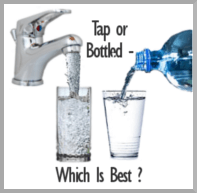Making The Right Choice
This article is not solely about weight loss, but a general observation on which is best, tap or bottled, whether on a weight loss or normal diet. In-depth analysis of what constitutes safe drinking water would need a series of articles on its own, but I will attempt here, to describe briefly the major points.
Is Bottled Water Healthier?
The majority of people, particularly those on a weight loss program, who use bottled rather than tap water, believe it is healthier and purer than what comes out of the tap.
healthier and purer than what comes out of the tap.
According to a report by the Chartered Institution of Water and Environmental Management (CIWEM), this is not true.
Briefly, the report says that, because of intensive marketing, it has led the public to believe bottled is purer and healthier than what comes out of your tap.
This is without foundation and that there are no major health benefits to be gained by replacing tap with bottled.
Also, due to the high mineral content of some bottled waters, it can have undesirable side effects on babies and young children.
What Are The Regulations For Water Purity?
There are three types of bottled waters: spring, mineral and drinking. So how do you know which one is safe to drink? You don’t, and until the regulations are changed, it is unlikely you ever will.
Unlike tap, which in the UK, and I imagine something similar in many European countries and the US, has to go through more than fifty stringent tests on a daily basis as to its purity and quality, the regulations governing the purity of bottled waters are, at best, extremely limited; at worst, virtually non-existent.
If the regulations governing bottled waters were as stringent as those governing tap water, many would probably disappear from shop and supermarket shelves.
The regulations regarding spring water are virtually non-existent. It can be collected at source, bottled and sold as is; although it is possible it is contaminated. It can also be purified by distilling and then minerals added to improve the taste.
As long as the source is on the label and it doesn’t include the words “natural” or “mineral”, it can still be labeled as pure spring water regardless of the fact that it is nothing more than distilled water with added minerals.
The regulations governing natural mineral waters are a bit stricter than for spring. Also, natural mineral water cannot be treated, apart from removing any debris like grit and dirt.
As far as purity tests go, it is only tested for less than a quarter of the chemicals and bacteria that have to be tested for daily in tap water, and is only tested as and when it suits the manufacturer or when they expect satisfactory results.
Believe it all comes from natural sources? Not so with bottled drinking water, it comes from the same lakes or reservoirs as what comes through your tap.
Don’t be misled or fooled by labels depicting gushing springs or tumbling mountain streams, all your are getting is what you would get from your tap, bottled for convenience, or from the same source as what comes through your tap, that has been passed through a reverse osmosis filtration system.
If you still feel unsure about the purity of what comes out of your tap, there are various ways you can further purify it, the obvious one being to boil it. You may find the post: Ways To Further Purify Water informative, on the various methods of water purification, that I have placed in posts.
As for the purity and safety of tap water, I have never drank anything else, apart from emergencies when there is no access to a tap, and have never experienced any problems.
Want to reduce the cost of your weekly weight loss diet overheads? Then why pay for something, apart from your annual water charges, that you can get for free!
Lifehacker.com: Tap or Bottled?
